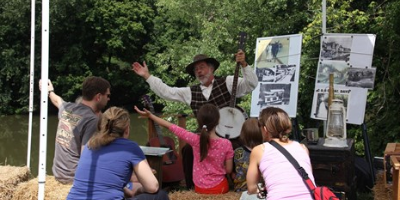|
Along the 184.5 miles of the C&O Canal, you will hear unique sounds ranging from man-made sounds (think sounds at a construction site) to various wildlife (think bats, birds, or buzzing bees).
Why Sounds MatterNatural sounds are part of a web of resources vital to park ecosystems! From the rushing waters at Great Falls to the sounds of bikers on the trail to Kingfisher bird calls, such sounds create immersive experiences important for wildlife, wilderness, visitors, and cultural-historic events. Protecting the unique sound environment of Parks is one of the many ways the National Park Service works to preserve important habitats across the country. Continue scrolling to learn the different ways sounds matter in National Parks. 
NPS and C&O Canal Trust Photo by Stefanie Boss Wildlife and WildernessAnimals depend on hearing sounds in their natural environment for many important activities like communication, finding food, protecting themselves from predators, and raising families, among other reasons. Loud sounds in the park landscape disrupt these and other animal functions. Learn about the effects of noise on wildlife 
NPS Photo VisitorsNatural sounds are important to your experiences in parks and can add different health benefits like lowered stress, better moods, feelings of joy, and well-being. Sounds connect you to the park environment and memories of your visit. Even sounds you hear often, like bird songs, wind through grasses and trees, frog croaks, and chirping insects are a secial part of the experience. Learn how noise can affect your park visit
NPS and C&O Canal Trust Photo by Lee Goodwin Cultural-Historic SitesThe sounds associated with our history or cultural heritage teach us about the past and connect us to distant times and places in a special way. They highlight historical aspects of a park and reinforce our nation's heritage. In this way, cultural sounds symbolize a time and place in history. The sounds of the loud canal horn approaching a lock, water rushing, filling the canal, and a canal boat "locking through" help us remember the C&O Canal during its operation. Learn how impacts the cultural-historic experience
NPS Photo Sound PreservationThe National Park Service works hard to preserve the natural and cultural sounds of National Parks. Managing the loud and inappropriate noise in Parks helps improve the quality of the soundscape, benefits wildlife, wilderness, and historic resources, and overall visitor experience. Learn more about what NPS does to preserve sound in National Parks ReflectionSit and listen quietly in your backyard or open window. What natural sounds do you hear? How easily are you able to hear the wildlife and wildnerness in your neighborhood? How do you think Parks, like the C&O Canal, help visitors journey into peace and relaxation? Sound GalleriesC&O Canal National Historical Park | Sounds Gallery
National Park Service | Sounds Gallery Additional Sound LibrariesColorado State University Listening Lab | Sounds of the Parks Yellowstone National Park | Sound Library and Audio Postcards — short stories about soundscapes unique to Yellowstone's ecology Rocky Mountain National Park | Sound Library Websites and ResourcesCheck out this creative NPS interactive wilderness website about NPS wilderness programs and places! |
Last updated: December 10, 2022
